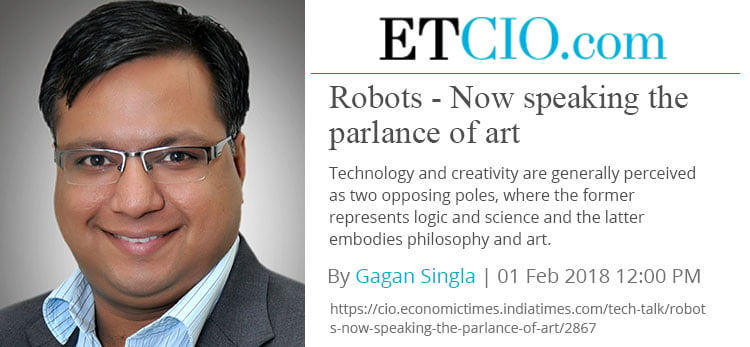
Technology and creativity are generally perceived as two opposing poles, where the former represents logic and science and the latter embodies philosophy and art. However, with a deeper gaze and further exploration, a strikingly different reality can be discovered.
Art is the output of a creative mind and we humans pride ourselves on being the only thinking species in the universe; hence relegating art as something unique to us. Robots, on the other hand are one of the greatest tech-marvels that work on the principles of science. In today’s digital world, robots can do anything that they are “programmed” to do – be it driving cars, performing surgeries, chatting with customers or processing tonnes of data in an instant. Still, it is the common belief, that robots can’t produce art as art is completely devoid of logic and replete with human sentiments and emotions – which the robots can’t feel!
But with a little reflection and analysis, you can find logic in every piece of art – one way or the other. Take for example, the cave paintings of the early men, the syllogism behind them is clear – these were nothing more than an attempt to represent their own surroundings and experiences. No doubt, the work of hand or expression makes them unique but you can still spot the rationale behind these. And hence, with a bit of creative thinking, indeed it is possible to programme a robot to produce things that can be termed as “art”.
But before we discuss AI and ART lets take a look at the sectors that have accepted AI with open arms. Healthcare, manufacturing, transportation, customer-service, marketing, financial services, journalism and entertainment are few of the top industries that are currently using AI systems extensively. In the financial sector, technology has enabled a new form of acceptance, expression and penetration. Ease of accessibility to technology has increased its all-round acceptance. Creative solutions augmented by AI systems are being preferred and invested in, over the traditional ones. The sector is not fearful of technology any longer; instead it is embracing a creative destruction at the hands of technology. AI systems being used in the form of robo-advisory are proving to be better guides, helping investors to earn higher profits with zero bias recommendations.
With such sector-wide success it was just a matter of time before AI penetration would begin in the realm of art. Emergence of mediums like virtual reality has encouraged the creative fields to embrace intelligent systems for crafting new immersive art experiences, generating astounding results. Progress in the AI realm is pushing the boundaries of creativity and sensory experiences. It is being used for predicting trends by understanding and interpreting millions of data sets. Smart technologies are giving artists a chance to implement AI for creating intelligent masterpieces that can be used in real-life.
A classic example of such collaboration can be stated from the fashion industry where an internationally acclaimed designer duo teamed up with IBM’s smart technology “Watson” to create a new fashion line. “Watson” processed data comprising of almost 600,000 design and fashion images from around the world to understand and analyse different types of shapes and patterns. On the basis of this analysis, the system generated some unique patterns that it predicted were likely to dominate the forthcoming fashion-cycle. The exercise saved the designers huge amount of time and money and also enabled them to create India’s first AI-inspired Western fashion collection. Thus establishing technology as a new medium that does not supress creativity but rather assist artists to improve and enhance creative design and expression.
Another example of popular use of AI in art is Prisma – an app that transforms any snapshot into a surrealistic painting. Google’s AutoDraw is also a platform that uses AI to transform people’s scribbles to perfect figures and drawings. A team at the Art and Artificial Intelligence Lab at Rutgers University is currently working on an AI system that will be capable of creating original art that will look as human-made as any master-piece exhibited at the art galleries. These smart systems use deep-learning techniques and analyse tons of photographs and sketches to create new pieces of art that include the imperfections of a hand-made master-piece.
AI has also entered the world of music – commonly believed to be an emotional art form. “Aiva” (Artificial Intelligence Virtual Artist) is an AI that has been taught to compose original music pieces. Aiva reads thousands of classical music compositions, extracts musical features from them and builds up an intuition of music theory by employing deep learning techniques. It then creates its own definition of music through an original mathematical model and with its help composes original sound-tracks that are used in films, games, etc.
AI is adding tremendous value to every sector where it is being employed and hence there is no reason for art to be an exception. Robots are not just expediting the creative process but also creating original pieces of art. There are sectors like the apparel industry where robot generated designs are being marketed as a distinct segment. Thus we can definitely say that robots are now giving birth to an alternate style – a style that the human artists might have to compete with in due time. Indeed robots are speaking the parlance of art, rendering potential for newer creative expressions across industries and paving way for an efficient and powerful environment.
Enjoy Zero Brokerage on Equity Delivery
Join our 2 Cr+ happy customers
Enjoy Zero Brokerage on
Equity Delivery